Rabbit Breeding: The Complete Step-By-Step Guide
After raising and breeding show rabbits for over 20 years the whole rabbit breeding process is not as easy as it might seem. On top of that some rabbit breeds are harder to breed than others but they all have their quarks.
There are so many things that can go wrong and sometimes you might not have any idea why. You will just have a season that goes not so great…
You just have to stick to it.
Getting good at breeding rabbits and having successful litters takes time. Even experienced rabbit breeders have issues.
In this post, I am going to walk you through the ins and outs of breeding adult rabbits and then give you some tips and tricks that I have picked up over the years.
Set Goals And Have A Purpose For Breeding Rabbits
Nothing should be done with no real reason behind it and breeding rabbits is no different. Set goals for your rabbitry and why you are doing these breedings. Is it to raise meat for your family? Then make sure to choose the right rabbits for that.
If you want to generate income then make sure to choose a breed that will help you make money from your backyard farm.
If you are not sure what your goals are make sure to check out the Intentional Backyard Farm Strategy Guide
Ideal Age To Breed A Female Rabbit
Just because a rabbit can get pregnant doesn’t mean she should. So how old do rabbits have to be to breed? The age is going to depend on whether you raise small breeds or larger rabbits.
- For giant breeds, like flemish giants and french lops, they need to reach their minimum breed standard body weight before breeding. For french lops, that’s around 10 months old.
You can find each breed’s minimum standard weight in the American Rabbit Breeders Association Standard of Perfection. – Just googling how big should your breed be could get you the wrong answer because other countries have different weight standards. So make sure it is the minimum weight for the ARBA if you are in the US.
- There are some larger breeds that are the mid-range in weight like Californians and New Zealand. For the rabbit breeds that are 9-10 pounds Sr. weight, I would personally wait until they are around 8 months old.
- For smaller rabbit breeds (under 7 pounds Sr weight) you can ideally breed them at 6 months of age.
Quick Note: If you are planning on showing your doe or you want her to fill out and reach their size potential you should wait until these ages are recommended. If you breed them too young (especially for giant breeds) it can really affect their growth rate and they may not reach their full size. In turn, ending their show career if they don’t make the minimum breed weight.
If you are not sure about your breed you can also message a rabbit breeder and ask them a few questions. Most are happy to help. Just be patient. Most don’t check their DMs as often during the winter months.
Free Farm Goal Planner!!!
➡️Get my proven system for choosing your farm goals so you don’t get burnt out.
Ideal Age To Breed A Male Rabbit
The fellas, well that’s a whole other story. It’s more of a “why are they capable and viable” question not so much can their body do the deed?
In my personal experience smaller breeds of young bucks can breed around 4 months old and large to giant breed rabbits reach sexual maturity around 7-8 months old. However, I have found that you should add about two months to each of those age ranges if you want to have a better chance at viable breeding.
I don’t find that bucks are as viable at such a young age. Can it be done? Sure, but if you want accurate breedings then you should plan to wait a bit longer.
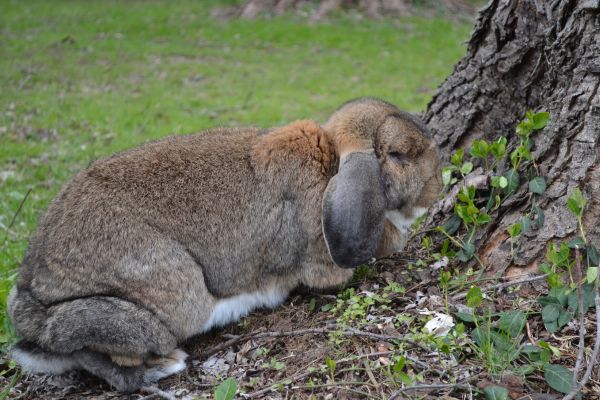
How Many Litters Can A Rabbit Have Each Year?
Let’s get one thing straight. Can and should are two different things. A doe can get pregnant right after her last litter is born. If your doe is producing meat for your family I would say no more than three litters a year. Personally, I wouldn’t do more than two a year.
Before you breed your doe make sure she is in good physical condition. She should have all her weight and fur back from her last breeding. Personally, I only breed my does once a year.
A reason to not overbreed your doe is if your doe is run down she will not be able to give as much nutrient to her litters if she is lacking herself. Resulting in more sickly rabbits.
Also does are born with the amount of eggs or “babies” they can have. So the more you breed her the sooner she will “run out” of eggs/ kits to have good size litters anymore. Once a doe is down to having smaller litters (only having 1-2 kits a litter) it is a good idea to retire her. Kits can get stuck during birth resulting in a slow and painful death of the doe.

The Rabbits Gestation Period
A rabbit’s gestation can be between 28-33 days but 31 is typical and ideal. A domestic rabbit nurses her litter to about three weeks old but the young rabbits should stay with the doe until they are about 6 weeks old.
When you are planning your breeding season you have to account for more than just the rabbit’s gestation. You also have to account for the 6-8 weeks that the baby rabbits will be in the nest box and with the mother rabbit.
If you notice that your doe is actively stressed and has had enough of the litter you can remove her from the litter. It is completely fine for rabbits can be separated into different cages at 6 weeks so the babies don’t have to compete for food. This will also give your female rabbit (doe) a chance to recoup.
That being said one litter can take up about 12-13 weeks in total.

What Time Of Year To Breed Rabbits
If this is your rabbit’s first litter. Look at the age of your breeding rabbits before you decide anything. You want to breed at the best the time for them physically is the most important decision-maker.
Then start looking into what the weather will be like during that time of year. Is it extremely hot, or cold, do you have bad storms in your area? I don’t like to breed my does in the hottest part of the summer to help avoid heat stroke and I avoided the dead of winter because that could lead to kits getting cold and dieing.
Sometimes you can’t have everything perfect so just be ready to deal with less-than-ideal weather if you have to.
How To Choose The Right Breeding Pair
Rabbits are not paired for life or choose their mate. There are a few decision makers to help you decide.
- If you are raising them for meat. Choose the rabbits that are in the best physical flesh condition.
- If you are raising them for pets start with temperament as the first factor.
- If you are raising show rabbits rabbits then they should meet the standards of the American Rabbit Breeders Association you should choose the best animals based on body type.
There is a pet peeve I have that rabbit breeders will choose a pair that have the opposite body type qualities. Assuming that the babies will get the best of both parents…. Like hu no?
That makes no sense at all.
Choose your buck and doe based on their own merit. Pair your best two animals together and always be on the lookout for breeding stock that is better than what you already have. Never buy breeding animals that are of poorer quality than the ones you already have.
Only when you are down to choosing between two breeding rabbits should you choose the one that has the better qualities that the other is lacking. Here is what I mean.
If you are breeding a doe that is lacking in width across the hips and you are trying to choose between two bucks that you already have that are pretty decent on their own. Then yes choose the one that has the width that the doe needs. But that should only be the very last thing you base your choice on.

It Will Be Easier If Both Breeding Rabbits Are Interested In Mating
This might be hard to believe but rabbits are not always ready and raring to go. Or there are times when even the buck will half-heartedly do his job.
The main reason a buck won’t be interested in breeding is if he is too young or its hot he has tried and worn himself out.
Clues that your doe is ready to breed:
- The female rabbits that are ready to breed will get cranky or at the very least not super friendly.
- She might grunt or even growl when you pet her on the head while still in the cage.
- Does are often hard to get out of their cage and are feisty when you are trying to handle them.

The Lift Test
You can test a does willingness to breed by putting her on a table and running your hand from the back of her neck to the top of her hindquarters. She will twitch her muscles, lift her hind legs, or stretch out longer instead of sitting the way you try to pose as if she were going to be shown.

Pro Tip: Weather has a lot to do with a rabbit’s willingness to breed. If there is extreme heat or humidity then don’t waste your time. BUT if the temps suddenly drop and the air feels cool then your breeding rabbits will often start to feel frisky. This is the best time to try breeding them if you have been trying to have a successful breeding but had no luck.
Hit the play button to watch now
The Rabbit Breeding Steps
Getting the “deed” done doesn’t take long at all. (We’re Talking 3-5 seconds if the buck is in the right position)
But getting the rabbits to get it right takes a few tries. Which is why it’s best to have your own buck. You will have a lot of wasted time if you try to use another local breeder’s buck.
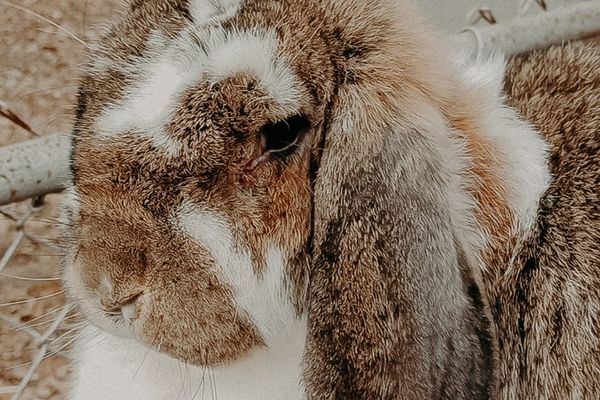
Where To Do The Rabbit Breeding
Always take the mature doe to the buck’s cage when doing the rabbit breeding if you are going to do it in the rabbit cage. Make sure to remove anything from the cage to avoid distractions and the rabbits injuring themselves on something in the cage.
Or you can take both animals to a neutral territory like a table and lay a carpet out and do the job there. Either way, make sure your rabbits have a good grip wherever they are standing.
You Might See Goofy Angles
Even if the buck is experienced it is likely that you will see him try several “not so good” angles at first.
Depending on the breed of rabbit you only have so much energy to work with so don’t let him waste it on the wrong end or off to the side. Get in there and put him in the right place if need be.

Note: I don’t think it is a good idea to leave your doe in with the buck for long periods of time. This could lead to your doe getting frustrated with him and even causing damage to the buck.
If your ultimate goal is to get rabbit meat… than you probably aren’t as concerned with the condition of the rabbits. But for show rabbits, one mishap could end a showing career.
The Doe Has To Be Lifting For The Breeding To Work
It is not going to work unless the doe is lifting her hindquarters. You can place your hands under her hips and lift her up some to help the buck get into the right place. You may even have to pull up slightly on her tail to get… ahem… things to be in the right place.
If your buck does his job he will make a grunting noise, freeze, and then fall off the doe in a rolling manner. Keep in mind that some bucks have their own quarks so one might look different than another. But that is the general mating process.
But NEVER count it as a successful breeding unless you get a fall off. If you didn’t see some form of that behavior from the buck. He likely didn’t get it right, simply humping a doe does not mean he is mating her.
Don’t Worry If You See What Looks Like Fighting During The Breeding
Sometimes a good healthy doe can be a little bossy with the buck if she is in the mood to be bred. This is a good thing. It doesn’t happen all the time but it is possible.
She might nip him (not bad enough to draw blood) or grunt and push him with her front feet and runoff. She is just flirting with him.

Not all does do it but it will make your life easier if she is just as willing to breed as the buck.
But her hormones don’t always have the best timing. So you will just have to get the breeding done in the time that makes the most sense.
Get help and find motivation as we build our intentional backyard farm together.
Breed The Same Pair A Second Time
If the buck has the energy, try to get him to mate again the second time. Two fall offs will increase litter size and often help make sure the breeding took.
If not you can bring the doe back to the buck in about 12 hours and do it again. If you are passed 24hrs just let it go and see what happens.
The babies grow in the doe’s uterine horn and then come down to the uterus to be born. It doesn’t always happen but if bred too far apart the doe can have two different age babies inside if you wait too far apart to do a second breeding.
She will deliver both at the same time causing the younger litter to be born too early. Considering that the gestatoin period of a rabbit is only 31 days one day is quite a bit of time.
After breeding, regardless of the method you use, check the doe’s vent to make sure the semen was deposited in the correct place. If the mating actually took place, you will find her vent wet. If you find a wet spot on her back or tail and the vent looks the same as before breeding, then the breeding probably didn’t work.
Wait a few minutes and try again when the buck has the energy.
Many people rebreed (I do as well) after an hour to increase the number of eggs released to increase litter size. The times I only get one fall off from the buck the litter does seem to be smaller of there is no litter born at all.
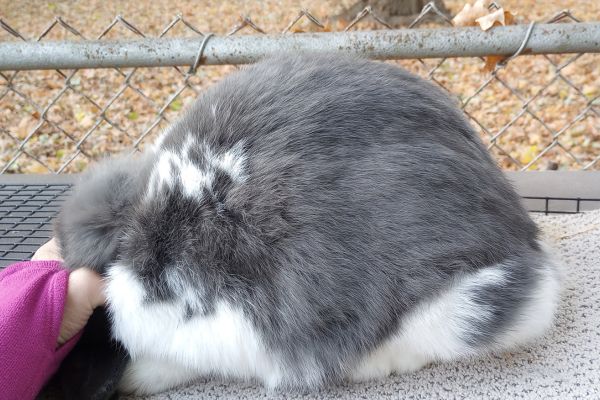
How To Tell If A Rabbit Mating Is Successful
There are several things you can watch for when you are checking to see if the breeding was successful and if your rabbit is pregnant. Thankfully the gestation period for rabbits is pretty short so there is some wiggle room if it turns out to be a false pregnancy.
You won’t be able to tell much until the doe is about two weeks along anyway and that is already halfway through the gestation period. Worst comes to worst you can breed again.
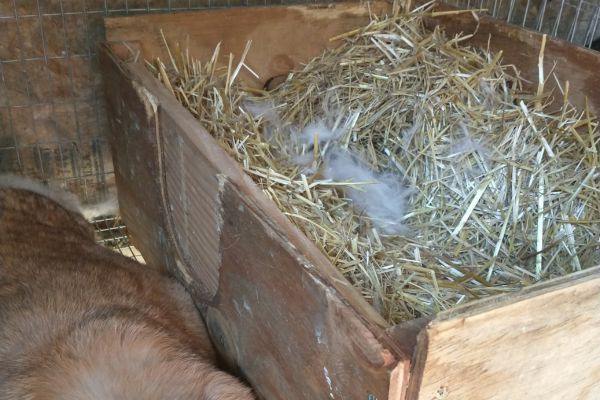
1. Her Mood Gets Better
Since does that are ready to be bred are often grumpy, this isn’t true for all does, her mood should get a little better after about a week of being bred. She is probably not sweet yet but she should chill out a little.
2. Wider Belly
Your doe’s mood should start to get better the closer she comes to delivery. Some does become very sweet by day 20 or so.
Your pregnant doe should start getting wider after about 14 days. If this is her first litter you might not notice for another week. By the time your doe reaches her 3rd week of pregnancy, you should notice a nice large belly and even some movement. Almost like her belly is rolling like a hotdog warmer. This is most noticeable when the doe is lying out flat and her belly is out to one side.
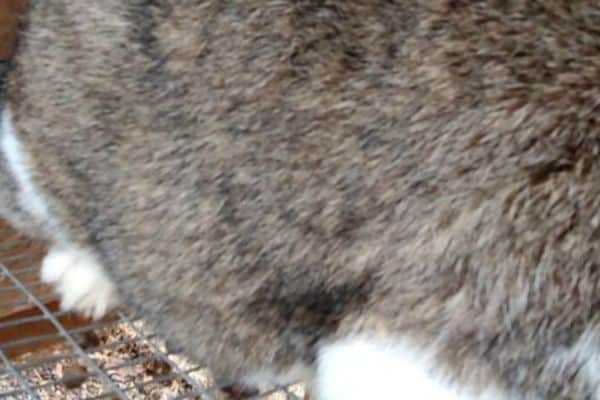
3. Palpating Your Doe
I am flat-out not good at palpating mainly because I raise such a large breed the babies can hide almost almost anywhere inside the doe and they are easy to miss.
That being said here is a good explanation of how to do it from Quality Cages.
Practicing palpation may require some practice. Older does are typically easier to practice on due to their more relaxed muscles and generally higher level of patience, compared to first litter does.
- Take the doe out of her cage and place her on a carpeted table.
- With one hand, grasp the doe over the shoulders to hold her steady.
- Take the other hand with the thumb and fingers opposing each other push up into the abdomen just in front of the pelvis.
Enough pressure can be used to raise the doe’s hindquarters nearly off the table. Don’t worry about hurting the doe. The chances of that happening are very slim. Each embryo is cushioned in its own amniotic sac, so what you are actually feeling is the fluid-filled amnion-not the embryo itself.
- At 10 days, the embryo feels like a firm blueberry.
- At 12 days, they feel more like marbles. (this is the point when it can be easy to mistake turds for babies)
- 14 days, they should feel more like large grapes or olives.
Once you feel an embryo or two, that should be good enough and you can put the doe back in her cage.
One common mistake in palpation is mistaking round fecal pellets for embryos. To avoid confusion, remember that fecal pellets are small, very hard, and located closer to the backbone. Embryos, on the other hand, are found about midway into the abdominal cavity. If you squeeze fecal pellets instead of embryos, they will feel very hard, like rocks. Embryos feel more like firm fruit.
Personally, though I don’t like to deal with palpating mainly because I don’t have little rabbits. I can usually tell whether or not a rabbit is pregnant without palpating.
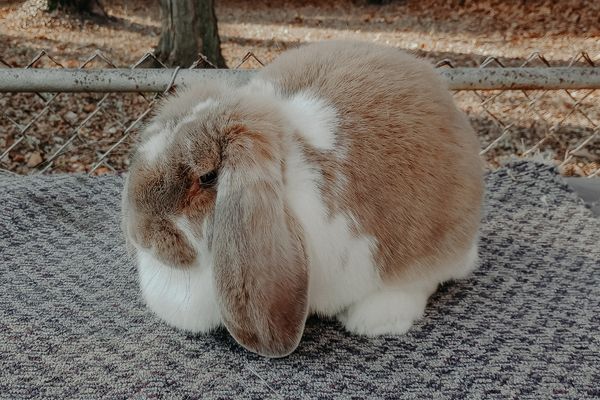
Things That Cause Rabbit Breedings To Fail
These are some of the most common reasons that I have lost litters myself BEFORE they were born or the breeding just didn’t work.
But you also need to know that sometimes years are just bad for having good litters and there is nothing you can do about it. And that’s ok. I remember one year at a rabbit convention I talked to an old-timer reputable breeder and he was having the same issues I was.
Things that cause litters to be lost:
- Storms or loud noises that scared the doe. – Things like fireworks or massive storms that are unusual for your area. Or trees falling on your property kind of bad…. ask me how I know.
- Changing feed to close to breeding – I never change feeds within 3 months of the breeding season.
- Feeding herbs or other foods that could have medicinal properties. – I LOVE herbs for my herd but I have found that they can also have a huge effect on the success of litters.
- A rabbit in a cage next to her is driving your doe crazy.
- Health problems that you might not see on the surface.
- Some lines just don’t work well together. – I have had one doe that would never have a successful litter with one buck but the others were fine.
- Not enough light exposure – This is more for the rabbits that are housed in a barn where there are few windows and they don’t have exposure to light as often. When the light is low that tells the rabbit’s body that it’s winter. And there is not food source a the ready. Meaning it is not a good time to raise a litter of kits.
- The buck is temporarily infertile. – This can happen to good bucks in the really hot summer months. His swimmers die from the heat in the scrotal sacs and it can take several breedings to “flush out” the dead ones. If multiple proven does have not been getting pregnant from this same proven buck then this is probably the issue. Choose one or two does that you can use him with and take the does to him as often as possible within a 24-hour period. BUT don’t keep breeding the does after that time so they don’t get pregnant with two different aged litters in her uterine horns. Treat these does as if they are bred because there is no way of knowing if the breeding was good. You just have to assume that it is until you have pregnant does again.
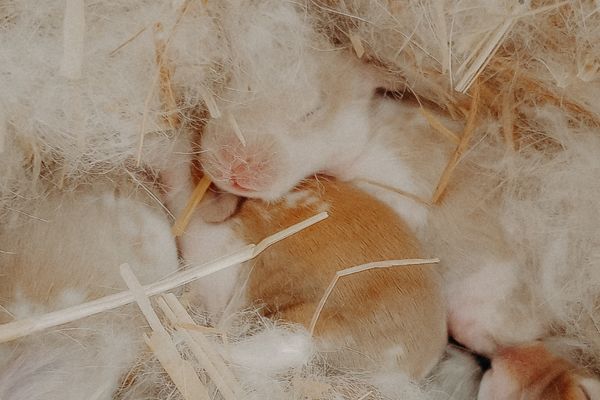
The Next Steps For Caring For A Pregnant Doe When Rabbit Breeding
Throughout the process do your best to keep the doe calm and around day 27-29 of per pregnancy you should give the doe a nest box for her to start building her nest for the kits.
You don’t want to give it too early or she could start using it as a toilet and that would not be good for the kits. It could also cause her to build her nest outside the nesting box.
Fill the wood nestbox with straw about halfway full so the kits can’t get out but are still able to be completely covered after they are born. For french lops, the nest needs to be about 6 inches deep.
Anytime you are having issues with litters the main thing is to boil it down to the basics. Think about them in nature. What could trigger them to think now is not a good time to have baby rabbits?
Rabbit breeding takes patience and a little practice. If you are having a hard time just keep going and tell yourself that you can quit but not on a bad day.
Ready for the next step? Learn about rabbits giving birth and what the process looks like.
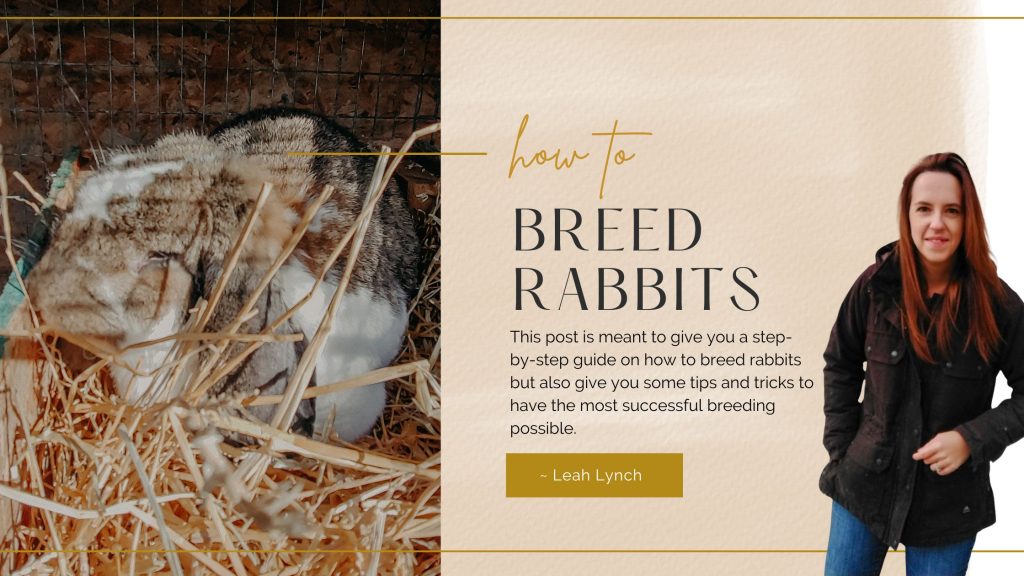
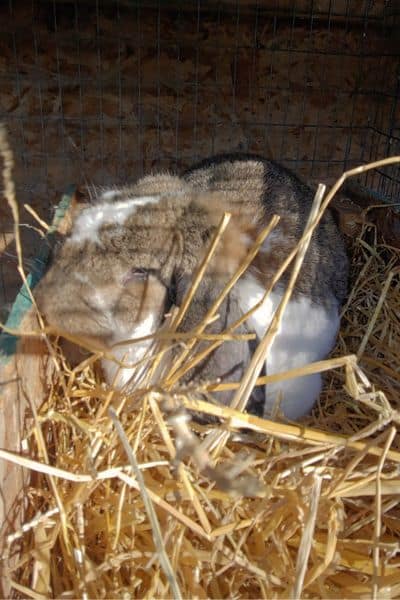




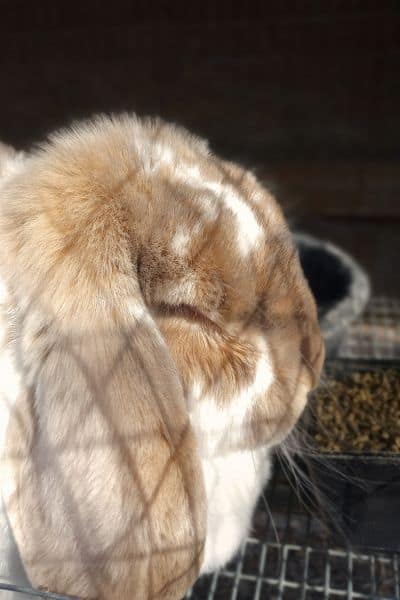
One Comment
Comments are closed.